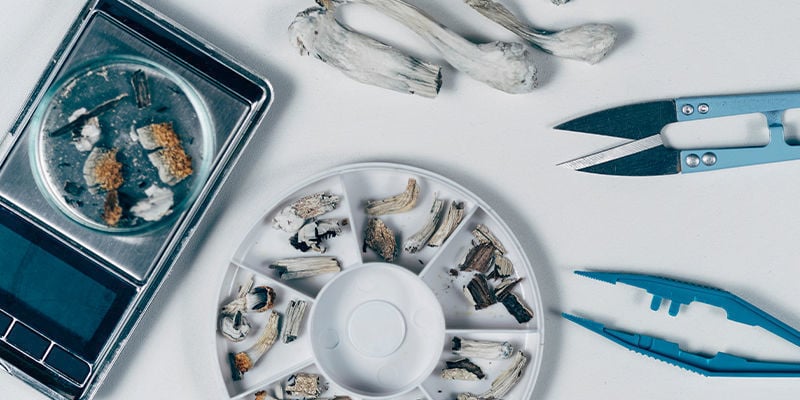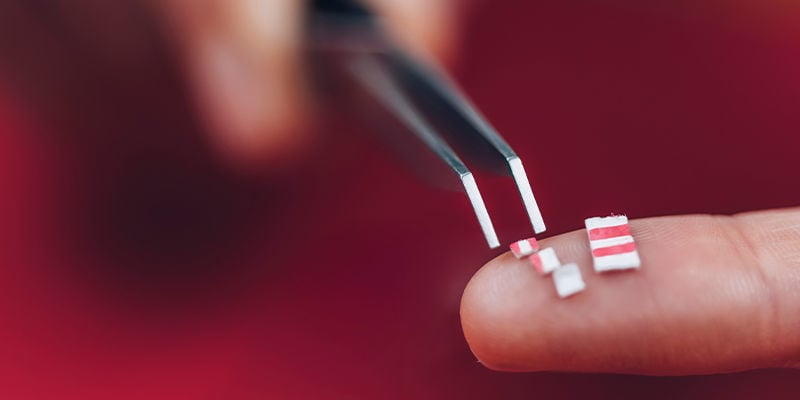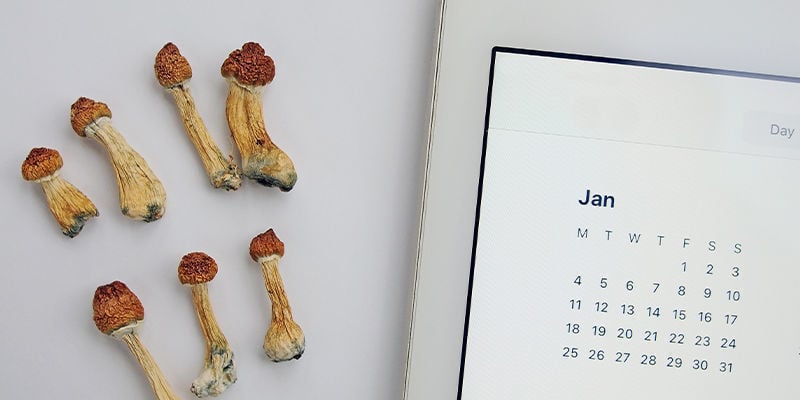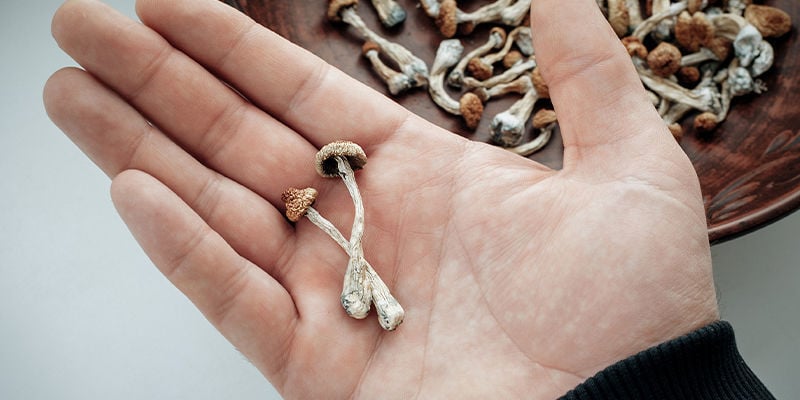
How Often Should You Microdose?
Taking tiny amounts of psychedelics could boost your focus, creativity, and mood, all while you go about life as usual. Welcome to the practice of microdosing. But just how often should you do it? And how can you tell if it's working? Let us break it down for you.
Would you take magic mushrooms every day? Every three days? What if it was just a little bit?
Microdosing is all the rage, with everyone from stay-at-home moms to Silicon Valley entrepreneurs touting its rewards. The practice has gained popularity as research into psychedelics highlights possible therapeutic benefits.
But how does microdosing work, and just how often should you do it? We've got answers.
What is microdosing?

Microdosing is the practice of taking psychedelics at extremely low doses. These "micro" doses are far below the threshold of what it takes to trip out. The effects of a microdose are therefore sub-perceptual or sub-hallucinogenic. Essentially, you don't notice any obvious distortions in your perception of reality.
So, why would anybody microdose? Just because the effects are subtle doesn't mean nothing is happening.
What are the potential benefits of microdosing?
The aim of microdosing is to experience subtle changes over time. Rather than being a one-and-done kind of thing, proponents microdose repeatedly, along a set schedule. The goal of this gradual process is to garner some of the benefits of psychedelics while remaining lucid and functional in daily life.
Numerous qualitative studies have been conducted examining first-person microdosing experiences. A 2019 preliminary study in the Harm Reduction Journal developed a codebook of microdosing benefits and challenges (Anderson et al.). The study was based on reports from 278 microdosers.
According to the data, possible benefits of microdosing include:
✅ Improved mood
Microdosers often cite beneficial changes in mood and a feeling of overall peace and well-being. Others mention greater optimism, spiritual and emotional insights, improved outlook, and appreciation of life. Some even claim to experience increased sociability.
✅ Enhanced focus and energy
Some people microdose to improve focus, productivity, and self-efficacy. Microdosing has become popular in Silicon Valley and further afield for this reason. Anecdotal reports detail increased awareness, mindfulness, engagement, and attentiveness. Some have noted feeling more alert, wakeful, and stimulated.
✅ Increased creativity
There is a growing body of research into the effects of psychedelic substances on creativity. Study participants have reported enhanced creativity and meta-creative processes—divergent thinking, curiosity, openness, and the ability to shift perspectives.
✅ Decreased cravings
Psychedelics like psilocybin have been studied for their potential to help with addiction. With that said, some people may microdose to curb cravings for substances such as alcohol or caffeine (Bogenschutz et al., 2015).
✅ Physical effects
Anecdotal evidence sees some individuals microdosing in hopes of impacting migraines, menstrual pain, and other types of pain.
Which substances can you microdose?

While some users will microdose a wide range of substances, including cannabis, microdosing is typically done with psychedelic drugs. Common substances for microdosing include:
- Psilocybin (magic mushrooms)
Psilocybin is currently being vetted for its effects on major depression and addiction recovery. Some users report greater spiritual and emotional openness under the influence of this substance (Johns Hopkins Medicine, 2020).
- LSD (lysergic acid diethylamide)
LSD is one of the most popular substances to microdose. It is often used with the goal of increasing focus, productivity, and creative thinking.
- DMT (dimethyltryptamine)
Plants containing DMT are used in shamanic practices among indigenous Amazonians. It is known as the "spirit molecule". Microdosing DMT may affect mood and other emotional processes. Some people use it in hopes of increasing mindfulness and focus (Cameron et al., 2019).
- Iboga (ibogaine)
Iboga is a root bark containing the psychoactive compound ibogaine. It is used ceremoniously by the Bwiti people of central Africa. When microdosed, iboga may boost creativity, mood, and help to curb cravings.
How much is a microdose?

A microdose is typically 1/10 to 1/20 of a normal dose. Here are some typical doses for comparison:
Psilocybin mushrooms (dried stems and/or caps)
Microdose: 0.15–0.3g
Creative dose: 0.5–1g (test out these doses before taking them at work!)
Typical trip dose: 2–3g
LSD
Microdose: 10–20μg
Creative dose: 40–50μg
Typical trip dose: 100μg
Of course, everybody is different, and you may need to experiment to find your optimal dose. Depending on the substance, doses may also vary between batches. Consider using a dosage calculator to get a better idea of the ideal amount for a given scenario.
Finding your threshold dose
You may want to start by finding your "threshold dose". This is the dose at which you start to feel slight hallucinogenic effects. These effects may be very mild, but are clearly perceptible.
To determine your threshold dose:
-
Start by taking a dose slightly higher than a standard microdose. The goal is to notice mild psychoactive effects from the drug. For obvious reasons, it's best to do this on a weekend or other low-responsibility day.
-
Next, slowly reduce the dose. Determine the lowest possible dose at which you feel obvious effects. This is your threshold dose.
-
From there, this knowledge allows you to establish a starting point for your microdosing journey. You can experiment week to week with doses below your threshold to find a good starting dose.
Microdosing schedule: Choosing the right one for you

Different microdosing schedules have been proposed and tested over the years. It's important to find the right one for you, and many people tweak their schedule and dose as needed.
While popular microdosing protocols differ, they all agree on three things:
- Don't microdose every day
- Microdose for at least one month
- Self-observation and mindfulness are key
Okay, so how often should you microdose? Here are a couple of schedules to start with.
The Fadiman protocol
Dr James Fadiman is known as the "Father of Microdosing". He has been active since the 1960s and is renowned for his pioneering studies and scientific research into psychedelic drugs. Since 2010, Fadiman has gathered data from thousands of people who have experimented with microdosing psychedelics.
The Fadiman protocol is the first standard microdosing regimen ever developed. It consists of:
-
A dosing schedule of one day on, two days off (microdosing every third day) for ten weeks.
-
Microdoses ranging from 1/10 to 1/20 of a normal dose, taken in the morning and adjusted as needed.
-
Mindfulness and self-monitoring. Users are encouraged to follow their normal routine and self-observe, keeping a daily journal to monitor effects.
The Stamets stack
This microdosing schedule was developed by famed mycologist Paul Stamets. Stamets' approach was developed specifically for microdosing psilocybin mushrooms. However, it can be adapted to microdosing other substances.
The Stamets stack recommends:
-
A dosing schedule of four days on, three days off. In theory, the effects of the microdose accumulate when taken over a longer period. The three days off at the end of the week are to reset the body's tolerance.
- Combining psilocybin with lion's mane mushrooms and niacin (vitamin B3) to create the full "stack". You may decide to leave these additions out.
Experimenting with your schedule
A more experimental approach focuses on flexibility and personalisation. Start by establishing your threshold dose. From there you can adapt to a schedule that works for you. Possible schedules include:
-
A schedule corresponding to a standard work week: microdosing Monday–Friday (or equivalent) with weekends off.
-
A one-day-on, one-day-off schedule, adjusted as needed.
As with other protocols, the key here is to be mindful of your mental and physical experiences day to day. A high level of awareness allows you to more easily adjust your schedule as needed. It can also help you to recognise if you are building a tolerance.
How long should you microdose for?

Microdosing is a process geared at gradual improvement over time, so allow yourself time to reap the full benefits of your regimen.
It's preferable to microdose for at least one month. Of course, if you experience adverse effects, you should stop earlier. The Fadiman protocol suggests microdosing for 10 weeks. At that point you may choose to stop completely, or take an extended break and start another cycle.
Can you build a tolerance while microdosing?
As with any regular substance use, you can absolutely build a tolerance while microdosing. This is one of the reasons you shouldn't microdose every day. Taking breaks helps to minimise tolerance and side effects.
Top tips for microdosing

Here are some final tips and recommendations to keep in mind to get the most out of microdosing.
💡 Use a trusted source
It goes without saying that the safety and efficacy of microdosing is dependent on the quality of the psychedelic substance you microdose. Always use a trusted source of consistent, properly cultivated or synthesised psychedelics.
💡 Know that each substance is different
The most popular substances to microdose are psychedelics. However, that doesn't mean your experience will be comparable between hallucinogens. Microdosing LSD can have different effects than DMT.
The size of your dose and even your microdosing schedule should be tailored to each substance. You might be experienced with microdosing psilocybin, but that doesn't mean you're a seasoned microdoser of iboga. Always approach each psychedelic substance with caution, curiosity, and respect.
💡 Set a goal
What do you hope to get out of microdosing? Maybe you want to boost creativity, improve your mood, or work on being emotionally open.
Setting intentions can help to guide your experience. Having a defined set of goals or questions to explore allows you to track your progress. You should remain open to new or unexpected experiences. At the same time, be sure to establish a starting framework through which to begin your observations. This will help you to understand, as you go, if microdosing is benefitting you.
💡 Keep a record
The changes from microdosing can be subtle. We can't emphasise enough the importance of keeping a journal or other method of tracking your experience. Use a consistent set of metrics and check in with yourself daily.
Points of observation may include:
-
Creativity and problem solving: Are you noticing or appreciating unique qualities in your surroundings? Are you generating more ideas than usual? Do you feel inspired? Are you finding it easier to come up with solutions to problems?
-
Focus and productivity: Are you able to concentrate? How attentive are you to your surroundings or to details in your work? Take a moment to centre yourself and be mindful. Does this come more or less naturally as the days progress? Is your mind clearer or fuzzier than usual?
-
Physical embodiment: How aware are you of your physical being? Do you feel any discomfort or notice any particular sensations? Do you feel grounded in or dissociated from your body? Do you notice any subtle alterations in your senses?
-
Mood and emotions: Do you observe any differences in how you experience emotions, or how quickly you process them? Is your outlook more optimistic or pessimistic? Do you feel more or less depressed? Anxious? Do you feel more connected or more closed off from those around you? How would you rate your overall well-being?
Of course, there could be many more elements in your rubric. The important thing is to come up with a framework and record your observations diligently.
Is microdosing worth it?

Most research into microdosing is based on anecdotal, qualitative reports. While there is some empirical evidence supporting the benefits of the practice, more placebo-controlled studies are needed.
A study in the journal Translational Psychiatry concluded that "expectation underlies at least some of the anecdotal benefits attributed to microdosing with psilocybin mushrooms" (Cavanna et al., 2022). In other words, the placebo effect is likely a factor in some individuals' subjective experiences. However, the question of placebo effect doesn't negate the plethora of positive reports. More research is required.
It's safe to say that whether microdosing is “worth it” largely depends on personal experience. The only way to know for sure is to try it yourself. For many, it's worth exploring, and there's a growing microdosing community out there to support you on your journey.
Microdosing is not a magic bullet, but rather a tool. We hope we've armed you with the knowledge to determine if it belongs in your toolkit.
Shroom Shop
Zamnesia's Shroomshop offers an extensive selection of mushroom cultivation supplies, including spore prints, liquid cultures, grow kits, and much more.
- Anderson, Thomas, Petranker, Rotem, Christopher, Adam, Rosenbaum, Daniel, Weissman, Cory, Dinh-Williams, Le-Anh, Hui, Katrina, Hapke, & Emma. (2019, December). Psychedelic microdosing benefits and challenges: an empirical codebook - https://harmreductionjournal.biomedcentral.com
- Cameron, Lindsay P., Benson, C. J., DeFelice, B. C., Fiehn, O., & Olson, D. E. (2019). Chronic, Intermittent Microdoses of the Psychedelic N,N-Dimethyltryptamine (DMT) Produce Positive Effects on Mood and Anxiety in Rodents. ACS Chemical Neuroscience - https://pubs.acs.org
- Cavanna, Federico, Muller, Stephanie, de la Fuente, Laura Alethia, Zamberlan, Federico, Palmucci, Matías, Janeckova, Lucie, Kuchar, Martin, Pallavicini, Carla, Tagliazucchi, & Enzo. (2022). Microdosing with psilocybin mushrooms: a double-blind placebo-controlled study - https://www.nature.com
- Johns Hopkins Medicine. (11/04/2020). Psychedelic Treatment with Psilocybin Relieves Major Depression, Study Shows - https://www.hopkinsmedicine.org
- Michael P Bogenschutz. (2015). Psilocybin-assisted treatment for alcohol dependence: a proof-of-concept study. Journal of Psychopharmacology - https://journals.sagepub.com
-
 5 min
November 7, 2024
Everything You Need To Know About Microdosing Psychedelics...
When you think about consuming cannabis, magic mushrooms, acid or peyote, what springs to mind? Probably crazy visuals, couch-locking highs and journeys into the unknown. These days another way of...
5 min
November 7, 2024
Everything You Need To Know About Microdosing Psychedelics...
When you think about consuming cannabis, magic mushrooms, acid or peyote, what springs to mind? Probably crazy visuals, couch-locking highs and journeys into the unknown. These days another way of...
-
 3 min
June 26, 2023
Using Magic Mushrooms For Studying: Does It Help?
When exam period approaches, it can be tempting to turn to drugs to assist us in our studies. But how can you use them in a way that actually helps? In this article, we delve into the topic of...
3 min
June 26, 2023
Using Magic Mushrooms For Studying: Does It Help?
When exam period approaches, it can be tempting to turn to drugs to assist us in our studies. But how can you use them in a way that actually helps? In this article, we delve into the topic of...











 United States
United States









